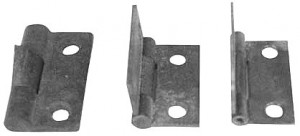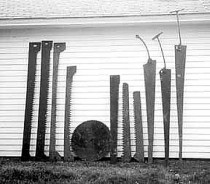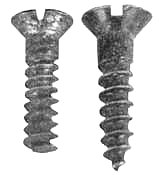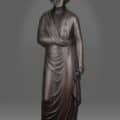System for Dating Country & Primitive Furniture, Part1
The Business of Doing Business in Antiques – The Journal of Antiques and Collectibles – July 2002
Have you ever tried to pinpoint the construction date of a country cupboard? The stylistic techniques used to date formal furniture such as Chippendale and Hepplewhite simply does not work for American country and primitive furniture. Country furniture does have its styles based predominately on religion and region. The catholic French and the Irish built cupboards with bold moldings, cut out feet, raised panels and they painted their cupboards in bright colors. The puritan New England cabinetmakers built simple unadorned cupboards painted in drab colors.
The Shakers are well known for their simple but elegant furniture. Furniture built in the Midwest and the South is different from New England made pieces.
The problem with using style to establish the construction date of country and primitive furniture is that regional styles remained unchanged for most of the 19th century. Unable to use style, dealers and collectors have turned to the telltale signs left on the furniture itself by tools and by construction methods. This system is remarkably accurate to within a ten-year period.
During the Industrial Revolution, the method of making nails, screws, hinges, latches, and of milling lumber changed often. Each change is documented, most are patented. The style of nails changed a dozen times, the hinge changed four times, the screw changed three times, and so did latches and pulls. The methods of working wood also changed during this time. The saw changed, molding styles changed, mortising changed.
Since it is impossible for any item to be older than the technology that made it possible, a chronological system of the advancement of cabinetmaking technology can be used to establish construction dates to within a few years.
The up and down saw leaves marks on wood that look like this |||||||||||||. The circular saw leaves marks on wood that look like this ))))))))). The pit saw leaves marks on wood that look like this ///////////.
The pit saw is a two-man powered saw used in America before 1680 to cut logs into boards. After 1700, its major use was as a large jigsaw to shape knees, ribbing, and planking for ships.
The up-and-down saw, was used in this country from the 1680s until early in the 1900s. Therefore, most boards used in the construction of early cupboards show signs of being cut with an up-and-down saw.
The circular saw although introduced in the mid 1850s could not be made big enough and powerful enough to cut lumber of the size used in furniture construction until 1880. The circular saw was limited to cutting thin pieces of wood such as shingles, clapboards, and laths until the early 1900s. Cupboards and other furniture in which the large size boards used in their construction are circular saw cut can date to 1880, but usually date after 1900.
The rough sawed lumber used in furniture construction was smoothed with either a hand held plane, or a planing machine. The hand held plane was used in this country from the beginning until after 1900. Planing machines were experimented with early in the 1800s. Two early experiments are the Woodworth planer in 1824 and the Daniels planer in 1834. However, a perfected machine was not developed until 1860. Lawsuits over patent rights prevented its use until 1880. Machine plane marks are of some use in dating cupboards made as early as 1860, but machine plane marks usually suggest a construction date of 1880 or later.
The introduction of the modern looking butt hinge used to hold doors on cupboards dates to 1820. Before 1820, hinges were made one at a time by a blacksmith. The first butt hinges were made out of cast iron. They were thick and heavy. By 1840, cast iron hinges became thinner as manufacturers tried to squeeze more hinges out of each pound of iron. By 1880, the use of cast iron in the making of butt hinges was discontinued in favor of stamped steel.
The common wood screw underwent a major change in 1846 when T. J. Sloan of New York City invented the first machine to mass-produce this item. Sloan holds many patents for cutting threads, shaping points, and forming the heads of screws.Before 1846, all screws were handmade and the slot in the top of the screw was hand cut with a hacksaw. Seldom was the cut placed exactly in the center. Because the new machine made screw was inexpensive, it was readily accepted by cabinetmakers. Items made after 1846 are made using this new screw.
For the first ten years of production, machine made screws were made with no slot in their head. The slot still had to be cut by hand with a hacksaw. Country furniture made with these screws can easily be dated to the ten-year period 1846-1856.The Mercer Museum in Doylestown, Pennsylvania has samples of Sloan’s screws on display. The Mercer library contains materials on both machine made screws and methods of cutting screws by hand.
In 1871, cast iron latches became available to cabinetmakers. After the introduction of the cast iron latch, most cabinetmakers used this new feature in place of the little wooden turnstile that had been used for centuries.
In the South and Midwest, hand-cast brass latches were in use before 1850. These early latches were inlaid into cabinet doors rather than being attached to the surface, as were the later cast iron latches.
Dealers who specialize in country and primitive furniture have depended on the above methods (plus the study of nails) for dating their antiques. Many dealers feel that the technological system is superior to the stylistic system. Furniture styles linger for years. New technologies, because they bring cheaper prices or faster methods, are accepted quickly – usually within a year or two.
The Dating of Old Houses, a paper prepared by Dr. Henry C. Mercer, contains photographs, drawings, and patent information on nails, hinges, screws, hardware, planing machines, etc. Call the Mercier Museum, Doylestown, Pennsylvania (215-345-0210) during business hours for information on reprints by The Bucks County Historical Society.
Next month’s column (Part 2) is devoted entirely to the development of the machine cut nail in America.

The hinge above (broken) is made of cast iron and measures 1/8 inch thick. This hinge dates to about 1820. The hinge in the middle is thinner and was removed from a cupboard made about 1860. This hinge measures 1/16 inch in thickness. The hinge on the right is a modern hinge. It was removed from a house when the kitchen cabinets were undated. The hinge dates to 1940. It is 1/32 inch in thickness and made out of stamped steel.Stamped steel hinges began to appear in 1885.I began collecting up and down, pit, bolt, and early circular saws to study saw construction and the marks each type of saw left on the wood it cut. The four saws on the left are waterwheel powered up and down saws. They leave a down cutting mark between 3/8 and 5/8 inch wide and one up drag mark 1/32 inch wide as the blade is pulled up. The circular saw was used to cut clapboards before 1880. The blade is thick, spins slowly, and makes a wide (3/8 inch) cut. Modern circular saws spin fast and cut very little wood on each revolution. The next three saws are bolt saws used by some mills to square both ends of a log before cutting boards. The three saws on the right are two-man powered pit saws used to handsaw logs into boards. The tall pit saw was used in a shipyard as a large jigsaw to shape timber for ship construction. For the purpose of scale and size, my garage is eight feet – six inches tall.
The screw above was handmade. The slot in the top was hand cut by a hacksaw. The screw on the right was machine made. The slot in its head was cut by a machine. There are many differences between a handmade and a machine-made screw. The shank of a handmade screw does not taper. The point of the handmade screw is blunt. By contrast, the shaft of the machine made screw tapers to a point. The threads are cut evenly and they pitch at a different angle than those of the handmade screw. The first machine made screw dates to 1846. The first machine made screw with a machine cut slot in its head dates to 1856.
Click here to view part two of this article.












Pingback: System for Dating Country and Primitive Furniture, Part Two | The Journal of Antiques and Collectibles
Re: article july 3 2002 regarding dating primitive furniture. I frequently see pointed screws
on English furniture ( and small pieces). Does this necessarily mean that the item was
made after 1846? Or was a pointed screw available in Europe (esp. UK) before 1800?
Thanks for any help. I have been perplexed by this for years. – – Carter Bays
Re: article july 3 2002 regarding dating primitive furniture. I frequently see pointed screws
on English furniture ( and small pieces). Does this necessarily mean that the item was
made after 1846? Or was a pointed screw available in Europe (esp. UK) before 1800?
Thanks for any help. I have been perplexed by this for years. – – Carter Bays